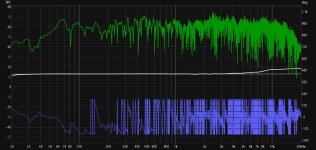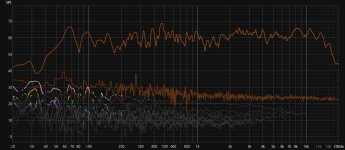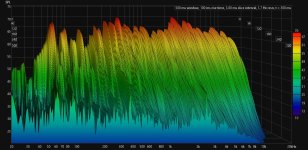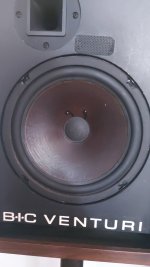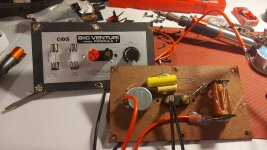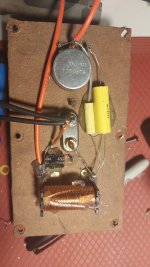I have been playing around with these in an effort to make them listenable. I mod podged the old paper cones and it made a huge difference in the sound, (for the better). Now I'm working on the crossovers. I'm trying to tame the peaks at 2-3khz. I added an inductor to the woofer and I think my next step is to add a capacitor across the woofer. Any suggestions or insights are welcome.
Attachments
Those peaks at 2-4khz and that's about it. This 8uF capacitor is my next attempt.
Attachments
Last edited:
I knew I should have gotten the mod podge with the sparkles. I know I'm putting lipstick on a pig, but ya know what? She's actually starting to look good. 👍
I hear most of the population won't get a sticker in first grade down there, but these are just rumors.OK, then historically due to the dustcap, so what I had good luck with was adding a centered five point star sticker like schoolteachers use to grade K-1st graders.
Sold a lot of those. Not a great oudspeaker, but they had good margins, peoople liked that they polayed loud. They provided enuff profit for us to become a real hifi store.
Puzzlekoated many a woofer.
dave
Puzzlekoated many a woofer.
dave
Last edited:
???I hear most of the population won't get a sticker in first grade down there, but these are just rumors.
If you can make these listenable, then hats off.
I had a set of Formula 1 when I was in high school. They sounded, well, worse than the measurements suggest. I can still hear the awful one-noted horn tweeters, and the harmonic distortion/mechanical noise when the woofers tried to reproduce bass above talking levels. Burrmmm burrrmmm flap flap flap.
I had a set of Formula 1 when I was in high school. They sounded, well, worse than the measurements suggest. I can still hear the awful one-noted horn tweeters, and the harmonic distortion/mechanical noise when the woofers tried to reproduce bass above talking levels. Burrmmm burrrmmm flap flap flap.
If it’s possible, try to take some measurements of the woofer and tweeter individually. My recommendation is to set the speakers on stands (or objects) and place the mic at 1m distance (39.37”), at tweeter height. You can also lower the mic height and experiment to see where the impulse response of both drivers more closely aligns, if at all.I added an inductor to the woofer and I think my next step is to add a capacitor across the woofer. Any suggestions or insights are welcome.
I don’t have these speakers anymore, if I did I would do some measurements right now for you.
With the crossover disconnected, measure the woofer alone and then the tweeter alone. To protect the tweeter, set the sine sweep to start at 1000Hz. The measurement doesn't have to be louder than speaking level.
Once you have the measurement plots, you can apply smoothing, such as 1/24 or 1/12 to average out the room reflections and get a little better idea of the response and phase.
It will be up to you if you want to measure the off-axis response. Power response is important, and collecting the off-axis data takes a bit longer.
The next step will be to export the response and use a crossover design app. If you can do impedance sweeps using a resistor jig and sound card/audio interface, that will make crossover design easier. If not, DC readings and guesswork will have to suffice.
BTW: If needed i may have a working horn (i do know i have a bunch of the horns without the driver)
dave
dave
- Home
- Loudspeakers
- Multi-Way
- B•I•C Venturi Formula 1 modifications and measurements
